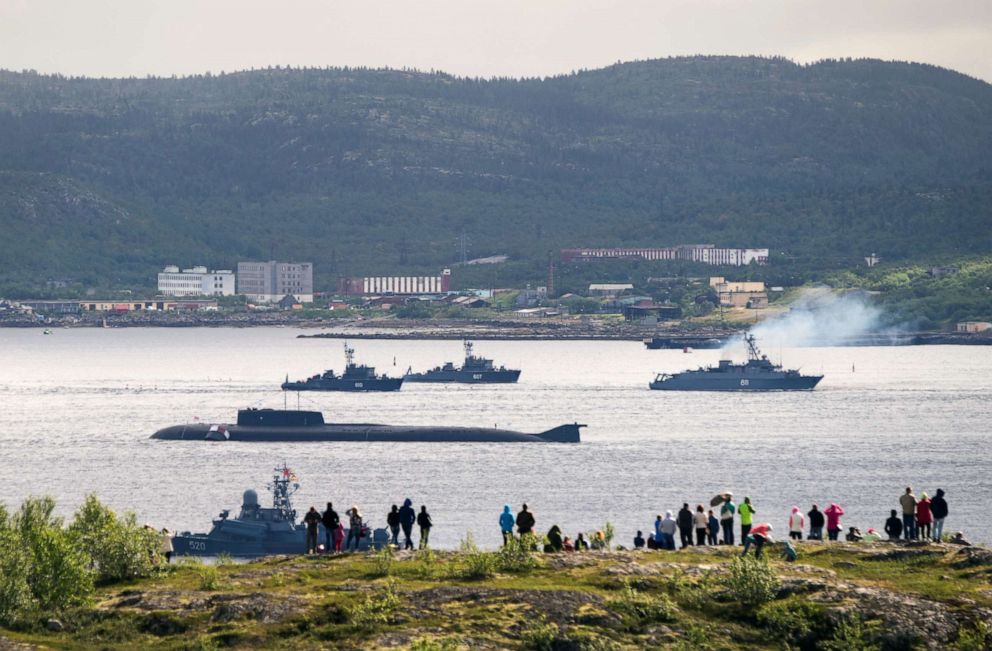Russia says submarine on which fire killed 14 is a top secret vessel
14 sailors were killed in the fire on of Russia's navy submarines
Moscow -- The Kremlin has said it will not identify the Russian military submarine where 14 sailors were killed in a fire because the vessel is top secret.
Russian media reports have increasingly suggested that it was a secretive nuclear-powered submersible used for deep water exploration and perhaps spying.
Russia’s military on Tuesday announced the sailors’ deaths, but said the fire had occurred the day before when one of its submersibles was conducting scientific tests in Russian waters in the Barents Sea. The submarine is now in the Arctic port of Severomorsk.

Russian officials have been tight-lipped about the incident. Russian media reports, however, citing defense sources, have identified the submarine as the AS-12/AS-31, a small deep-water submarine capable of operating at extreme depths and nicknamed the "Losharik."
The Losharik is one the Russian navy’s most secretive vessels and details about its design are hazy. But Russian state media reports over the years have allowed navy enthusiasts to build up a picture. Unarmed and nuclear-powered, Russian state media reports have suggested it can dive as deep as 10,000 feet. Relatively small, the Losharik reportedly can hold 25 crew and be attached to the bottom of much larger submarines. Designed in the late 1980s and launched in 2003, Russia has also largely succeeded in keeping the submarine out of view and only a few photographs of what are believed to be the submarine exist.
There were conflicting reports Wednesday on whether the fire had occurred on the Losharik itself and authorities offered no clarity on what had happened. The newspaper RBC quoted a defense source that the emergency took place on a separate capsule that can be lowered from the Losharik rather than the submersible itself.
Russian officials refused to confirm the reports. The Kremlin’s spokesman, Dmitry Peskov, on Wednesday told reporters that he could not identify the submarine because it was top secret.
"It belongs to the highest level of classified data, so it is absolutely normal for it not to be disclosed,” Peskov said. He also declined to say whether the submarine had a nuclear reactor aboard.
President Vladimir Putin on Tuesday also described the submarine as "not an ordinary vessel."
Russia has not said what caused the fire, but Norway’s nuclear safety agency on Tuesday told Reuters it had been informed by Russia that there had been a “gas explosion” on the submarine. Russia’s defense ministry denied it had communicated anything to the Norwegians.
The Norwegian Radiation and Nuclear Safety Authority also told Reuters that it had carried out tests and that there was no sign of elevated radiation levels in the area where the fire occurred, suggesting the submarine’s reactor had not been damaged.
The secrecy around the incident has fueled speculation that the submarine likely conducts spying missions and details emerging around the crew seemed to support the idea that the submarine was the Loshirak or another secretive deep-water reconnaissance vessel.
Multiple Russian news outlets on Tuesday reported that the vessel's crew are assigned to a military base close to St. Petersburg. The base, No. 45707, is attached to the Defense ministry’s Main Directorate of Deep-water Research, a top secret department that runs Russia’s deep-sea recon submarines. The crew was also unusually qualified: seven of the dead were captains first rank, and two had received the country's highest military honor, the Hero of Russia, according to the defense ministry.
Russia’s defense minister, Sergey Shoigu, who flew into Severomorsk on Tuesday to oversee the investigation into the fire, told a briefing that some crew had survived. The Russian newspaper Kommersant reported that 5 sailors were being treated in Severomorsk’s hospital.
Shoigu said the crew had saved a civilian aboard and prevented the ship from being destroyed, saying they had acted "heroically".
“They first of all evacuated the civilian industry representative from the module that was consumed with fire, sealing the hatch behind him in order not to allow the fire to spread around the whole deep-water capsule and themselves fought to the end to preserve the ship,” Shoigu said.
He said that all the dead would be nominated for state honors and that their families would receive all necessary support.
Russia's navy on Tuesday released the names of the 14 crewmen killed in the fire. The crew's commander was identified in some Russian media as captain Denis Dolonsky, who the navy said was one of the two sailors with a Hero of Russia award.
Shoigu described the crew as “unique military specialists,” calling them “top-notch professionals conducting important studies of the Earth’s hydrosphere.”
Russia has not given details about the submarine’s mission. The defense ministry said it had been conducting research to study the ocean depths and that the fire broke out when it was carrying out a “bathymetric measurement," which maps the sea floor.
Western naval experts have speculated that the Losharik and other Russian deep-water submarines might be used to tap communication cables on the seabed that carry most of the world’s internet traffic. In recent years, U.S. and British military officials have warned that Russian submarines have been spotted close to the cables.
A large annual NATO naval exercise, Dynamic Mongoose, also began this week off the coast of Norway, involving ships from European countries and the United States.




